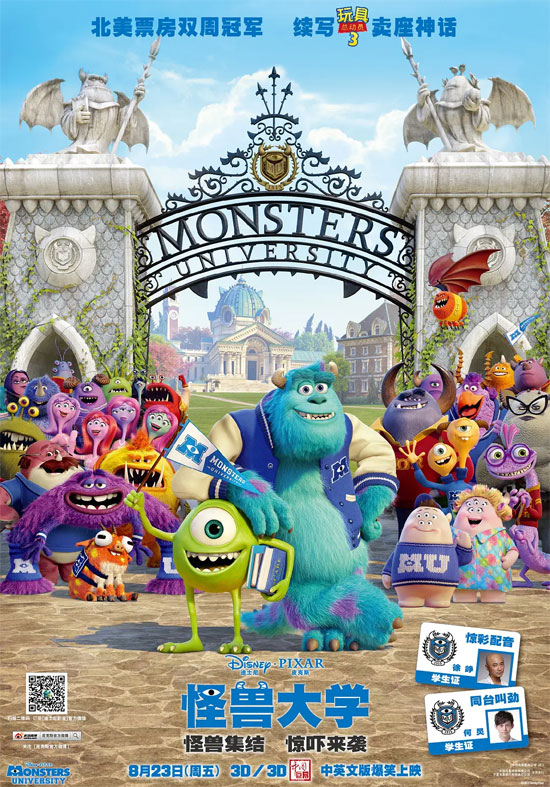Film Name: 怪兽大学 / Monsters University

I never attended college in the United States, so I cannot fathom that so-called free-spirited American campus culture. Even less can I condone the pervasive hierarchy and contempt for the weak that lurk beneath this veneer of freedom and abandon. Is this what they call a monster university? A place where “offending” the dean gets you expelled from the college? Where if you don’t look fierce enough or act assertive enough, you’re subjected to constant humiliation? Where someone can douse you in filthy water and then plaster your humiliating photos all over campus?
Is this what university is supposed to be—a paradise for the strong and a wasteland for the weak? Is this what a college is—a castle that appears impregnable on the outside, yet inside holds nothing but statues and portraits of so-called idols, or those desperate to mold themselves into idols? Are these clubs merely elite organizations adept at shifting allegiances with the wind? No, this isn’t university at all—it’s American society: a body that worships strength, a mind that crowns the powerful, eyes that see only heroes, and a mouth that speaks only through privilege.
Fortunately, the protagonist Mike is resilient, leading a group of underdogs surviving in the cracks of this culture of strength to stage a desperate counterattack. Through his own efforts, he ultimately gains everyone’s recognition—but only because he remains a wise and talented individual. In other words, he is still an elite. The film merely illustrates that elite status can be earned through diligent effort, unlike Sullivan, who attained it effortlessly through inheritance. Yet it also subtly concludes that one must become an elite to rise above, to live with dignity—otherwise, one faces bullying, contempt, and social irrelevance.
Thus, compared to those bizarre faces and monsters conceived through designers’ tortured imaginations, this elite culture might be the truly terrifying “monster” for the masses. In truth, the film’s emotional core isn’t the final mission completed by Mike and Sullivan, but the hard-won victory they achieve after defeating the so-called elite team in the campus scare contest. Because they were the underdogs who triumphed, the student audience erupted in such enthusiastic applause and congratulations. They vented the collective grievances of the masses onto the OK duo, who represented them. Little did they know that their applause and congratulations were merely the coronation ceremony for a new elite class.
What is college? It is a place where students gain enlightenment about life, an enlightenment that unfolds alongside knowledge and social interaction, deepening with every class and every activity. If all Mike and Sullivan learned in college was the importance of teamwork, leveraging individual strengths, and mutual respect—ideas that sound noble as “universal virtues” but can also be dismissed as “clichéd platitudes”—then why bother attending college at all? The greatest, most profound enlightenment they gained about life was the imperative to win, to enter the most prestigious college and become an elite.
Admittedly, in the opening scenes depicting Mike’s arrival at university, the film does vividly portray its dazzling allure and aspirational nature. Watching these moments, I was transported back to my own freshman year—the bonds formed with roommates, club recruitment drives, the tree-lined avenues, and iconic campus landmarks. I even imagined myself walking down the bustling main campus path like Mike. But when Sullivan strides into the classroom with an air of superiority and the elite clique casually dismisses the newcomers, that alluring vibrancy dissolves into a sleek veneer and façade for a survival-of-the-fittest value system. I knew it had drifted far from my own college experience and the university life I hoped to see.
Finally, a tangential note about Monsters University and Monsters, Inc.
It’s been so long since 2001’s Monsters, Inc. that I can’t recall its specifics. But with Monsters University’s release, I revisited the original with renewed interest—and found myself moved to tears. I recommend everyone revisit “Monsters, Inc.” after watching “Monsters University.” You’ll easily discern the sincerity of the original. In terms of motivation, the original focused on storytelling, while the sequel leveraged the brand for profit—an undeniable fact. “Monsters University” may have outperformed its predecessor at the box office, but its narrative quality falls short by more than a notch or two compared to “Monsters, Inc.”
“Monsters, Inc.” anchors its core imagination in the portal to the human world and the fundamental premise that monsters generate electricity from children’s screams. Its dramatic conflicts unfold not only among monsters but also through emotional connections with human children, filling viewers with wonder and the unknown. “Monsters University,” however, limits its core imagination to the university setting. The connection between the monster world and humans has become less novel, so its world-building feels superficial. The dramatic conflict unfolds almost entirely among the monsters themselves, reduced to simple rivalries, leaving viewers with little anticipation for the unknown.
While deeply moved by the cross-species bond between monsters and children in “Monsters, Inc.,” I recognize its creative foundation as an extension of “Toy Story”—a perspective from another realm contemplating how to interact with humans. “Monsters University,” however, feels like a monster-themed “Cars,” confined to a small world of endless races. It explores not how another world interacts with humans, but how beings from that world strive to live like humans. Clearly, the former is richer than the latter, encompassing the latter. Remember, this interaction is precisely what keeps audiences engaged.
Pixar’s finest works consistently operate at this higher level of conceptual depth—exemplified by films like Toy Story, Ratatouille, and WALL·E. Conversely, the studio’s more criticized recent releases, such as Cars and Monsters University, tend to remain confined to the shallower level of merely depicting interaction. This distinction may well become a key criterion for evaluating not only Pixar films but American animated blockbusters in general.
Please specify:Anime Phone Cases » Monsters University 2013 Animation Film Review: Monsters exist, but no universities